
I have long been a fan of Dorian Bracht’s Youtube page, following as he makes mind blowing joinery exercises. Now his book is out and sitting on my pile of stuff to read, having arrived during our recent eon of travel or I would have taken it along to read. The time will come when I can spend time at the bench and reproduce his work. Unfortunately that time is not yet here.
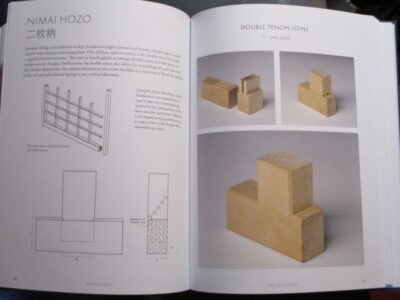
Our plan from the beginning of Tim’s bench-building visit was to fabricate what was essentially a kit, since everything had to fit as individual pieces into his compact station wagon for the trip home.
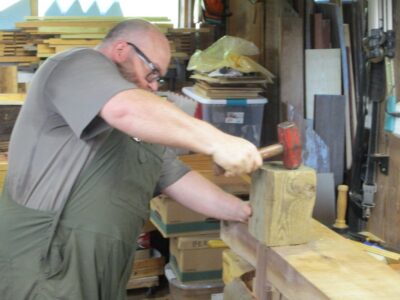
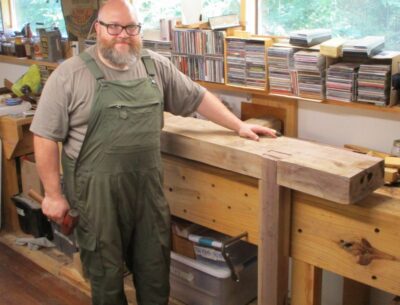
Our final day together was spent sorta assembling the bench to make sure it fit together the way we wanted. Since it was a split-top Roubo, we could each work on one half of it at different work stations. This was Tim’s first big woodworking project so I let him do much of the work.
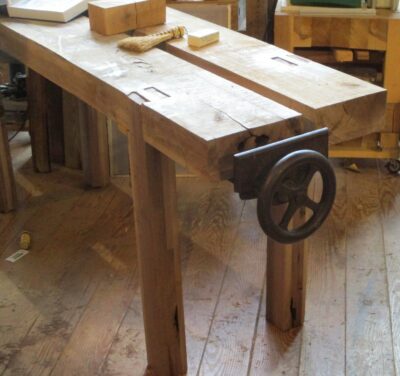

In the end we screwed some temporary cleats to the underside of the slabs in order to get it up on its feet, and mounted Tim’s piano maker’s vise for the obligatory pictures.

The rest of the work, installing the stretchers and cross battens and trimming the legs to length, will be accomplished by Tim once he gets back home.

We made exact measurements prior to beginning the construction so it all fit into his little station wagon, just barely clearing the rear hatch and dashboard.
And with that he was on the road back home to work on completing the bench as time allows.
NB – Tim has been making steady progress but the terminus has not yet arrived.
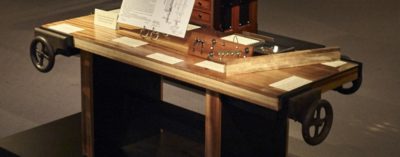
I first met Webmeister Tim during my research for the H.O. Studley tool cabinet book, probably around 2012 or 2013. I got an email from a fellow who said, “Hey, I think I’ve got a vise like the ones you are talking about.” I arranged to meet him in person at a diner in southern Maine and sure enough, he had a vise much like the ones about which I had been waxing ecstatic. Tim was a wood turner but not yet a full-spectrum woodworker, so he allowed me to borrow his vise to study, and eventually, to display in the 2015 exhibit that coincided with Handworks 2015. Of all the piano-lakers’ vises I’ve seen his is the closest to Studley’s.
Our agreement was that he would come and get it, “Whenever.”
Well, after more than a decade of long-distance friendship, including dozens of phone calls relating to the business of the donsbarn.com website, which he now steers, “Whenever” finally occurred last month. Finally aligning the stars of our respective lives, he was able to come to Shangri-la and spend a week with us in the Virginia hinterlands. It was truly a great time of fellowship and productive work together.
Our focus for the week was to build him a heritage workbench that would last the rest of his life and probably any eventual grandchildren and great-grandchildren as well. The raw material for the bench was my slabbed black walnut, the style of the bench a split-top Roubo.
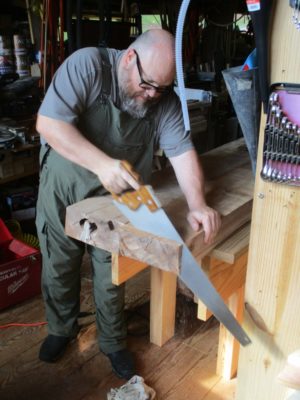
I worked him really hard during the week, beginning with hand sawing the almost 5″ thick slabs to length.

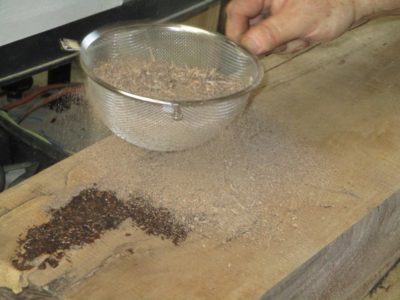
There were a couple of regions of the slabs needing attention, so we saturated them with diluted West System epoxy and walnut sawdust, followed by a top sprinkling of sawdust on top to provide a good surface for final finishing when it got to that point.
I did not have slab stock for the legs and stretchers, so we had to laminate them from black walnut cut from the same tree and some vintage stock I had in my lumber barn. For the newer stock we ran them through my little Ryobi 10″ planer that has been serving me well for about 35 years.


For the vintage stock from my barn, they had been planed eons ago so all they needed was a quick scrubbing with a wire brush to remove any debris and freshen up the surfaces for gluing.
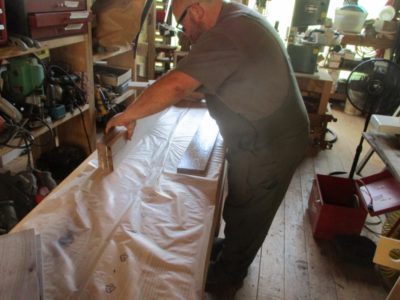

Then glued-up they were with T3 to accommodate any situation the bench might find itself in the future.
Thus endeth Day One of the Great Webmeister Tim Bench Build.
Whenever I have a metalworking file that gets to the end of its usefulness, whether for sharpening saws or just shaping metal over at the fabrication bench, and regardless of the cause of its infirmity — is it worn out or just boogered up? — I never discard the old tool. It is almost always a great source of very hard tool steel so it goes into my scrap inventory for me to make something out of later.
This habit and experience served me exceedingly well recently when we were up visiting L’il T (and his parents, of course). I carved out a little work station in their garage and just invent projects to occupy my time when I am not puttering around with house chores. Well, this trip I was making a tray for the traveling tool kit I bring with me. Much to my aggravation I realized at a particular point that I had not brought a dovetailing chisel for the small dovetails I was cutting into the ~5/16″ cypress stock I was using. My first attempt to chop the dovetails with my 1/4″ bench chisel did not yield a satisfactory result.
Since I am not at home on these trips I make a frequent, almost daily, pilgrimage to their local excellent hardware store. I set the project aside and figured I would see if the hardware store had a decent rack of steel bar stock I could use to make myself one of the triangular dovetailing chisels I like so much for small work. I have made several and find them indispensable for making tight petite dovetails. Although the hardware store did not have any bar stock that struck my fancy, I noticed their file rack nearby, and that they had a triangular file that would certainly fit the bill for about $7.
Sold.
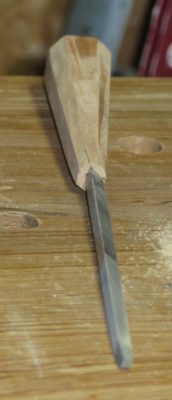
I brought the file home and set to work on it. Yes, it probably was a travesty to use a brand new file, but that’s all I had access to. My first task, undocumented alas, was to fashion a tapered octagon handle from some cherry in my scrap stash. I drilled and then drove the file tang into the handle. A little too vigorously, as it turned out. At some point soon I will fit the handle with a bronze ferrule, but I have not got there just yet.


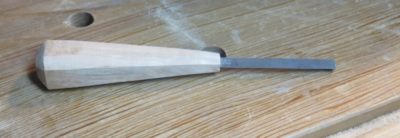
Using a Dremel tool with a cut-off wheel I chopped the file roughly in half.
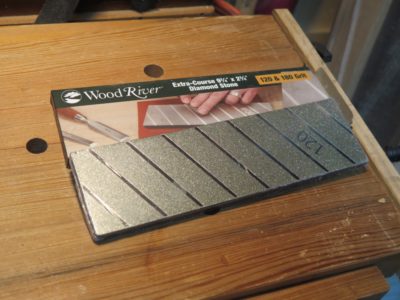
It was time to reach for my new-ish extra coarse diamond stone and get busy grinding off the file teeth and creating the bevel. This is exactly the kind of task this tool was created to accomplish, which it did surprisingly fast.
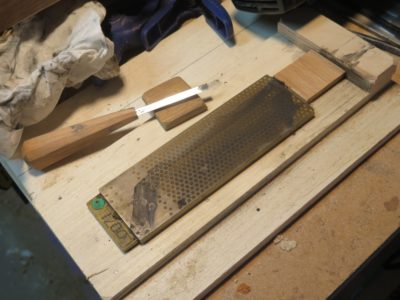
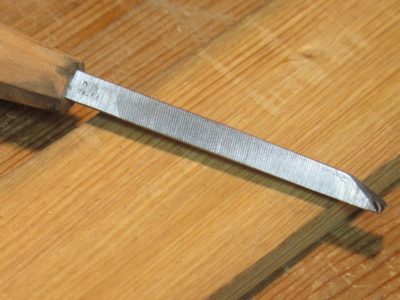
Once the coarse diamond stone had done its work I switched to the finer combination diamond to bring the surface to the place where it took only a few strokes on the 10,000 grit water stone to bring the bevel and the back to perfection.
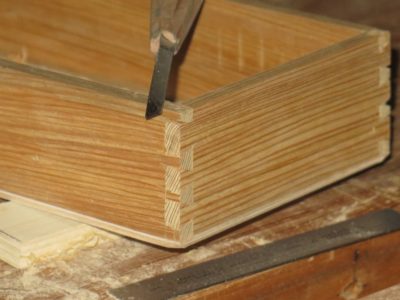
In battle the new soldier performed with valor. You can see the blow out on one of the dovetail shoulders resulting from using the 1/4″ bench chisel. The rest of the joint shoulders were fashioned with the new tool, which is rapidly becoming one of my favorites. The fact that I fabricated it myself by re-purposing something extant only enhances my affection for it.

1/4″ bench chisel vs. the new tool
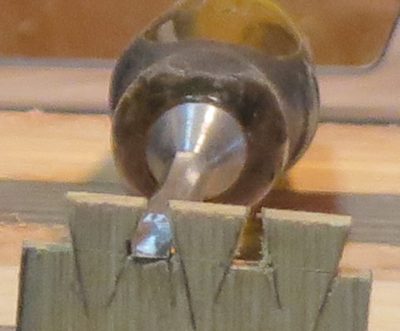






























Recent Comments